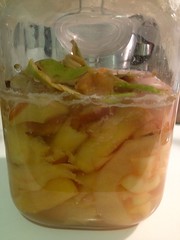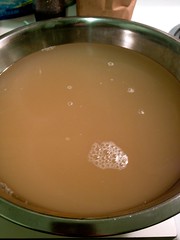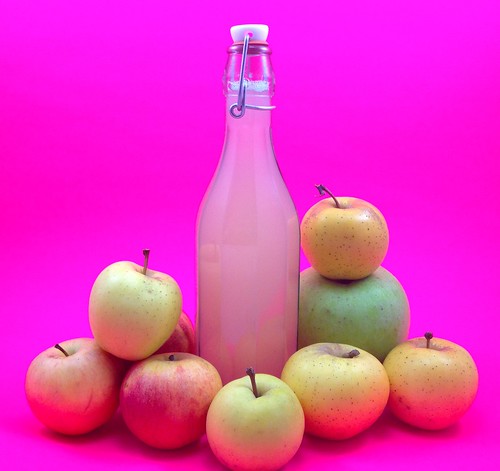Apples are all around us these days… no, not the computers and iDevices (well, those too), but the fruit. They’re cheap (and for some people, free!) and bountiful! And if you’re anything like I am, you might have a few apple projects up your sleeve, like apple sauce, apple butter, apple turnovers, apple pie, apple crisp… all delicious things you can make with apples.
But what to do with the peels and cores?

Ooh, a fermentation project!
Aside from throwing them away or composting, you can use them to make your own apple cider vinegar.
When I decided that I wanted to do things with the cores and peels, I did a little google searching, and came upon this. It seems to be more common to make the ACV with whole apples, but it can definitely be done with scraps, and to me, that’s a whole lot easier.
I started the process about 6 weeks ago, and now have some cider vinegar! I plan to use it for cleaning, baking and for dyeing my hair (I use henna). I would love to also be able to use it in preserving projects, but I’m not sure that it’s acidic enough. It sure tastes like vinegar, but without verifying the pH, I’m a little hesitant to use it where acid is needed to prevent me from killing someone with botulism.
I’ve toyed with the idea of getting a home pH meter, but people who seem to know more of what they’re talking about on the interwebs think that’s a bad idea, as the pH might not stay consistent during storage. I might buy one for fun, anyway though. Just because it would be cool to go around reading pH.
So you wanna make some ACV too?
Well here’s how!
Raw Unfiltered Apple Cider Vinegar
- Wash your apples, even if they’re organic, for any dirt, debris and pesticide drift. Add all the peels and cores to a bowl to get brown, and then into the jar (or put them straight into the jar, if that works better). Fill to the top of the scraps with filtered water. If there’s room and you’ll be making up more scraps soon in the next few days, you can add them once they’re brown, too, and top off with more filtered water.
- I also added a tablespoon of Bragg’s Raw ACV, just to make sure there was some nice, friendly bacteria in there to start the process for the first batch. For the second that I just started, I added about a 1/3 cup from the first batch for the same purpose.
- Next is the really easy part: cover the jar with cheese cloth secured with a rubber band, find an out-of-the-way and warm place for the jar, and leave it there for a month to six weeks.
- When you open it up, it will smell just like vinegar. It will taste like it, too!
- Now strain out the scraps.
- Bottle it up!
A couple of notes-
- I fermented mine on top of my fridge. It’s pretty warm there in my kitchen. Although it was only covered with cheesecloth, at no time did it ever smell like vinegar in my kitchen. Well, except when I opened it up to taste it. Then it smelled like vinegar, which I happen to like!
- I think this can realistically be stored at room temp, but I’m erring on the side of caution and storing it in the fridge. Why? I’m maybe a little paranoid. Plus, it’s where I keep my kimchi. I wouldn’t toss it if I left it on the counter for day, though.
- As I mentioned before, I would not use this for canning. I think it would be good for refrigerator pickles, though!
- When adding a little ACV to get things started, only use a raw, unpasteurized brand like Bragg’s. Do not use the regular kind.
Enjoy the fermentation process! I think this is one of the easiest fermented foods you can possibly make- and then you get to have a little science in your kitchen.






8 Responses to Make Your Own Raw Unfiltered Apple Cider Vinegar